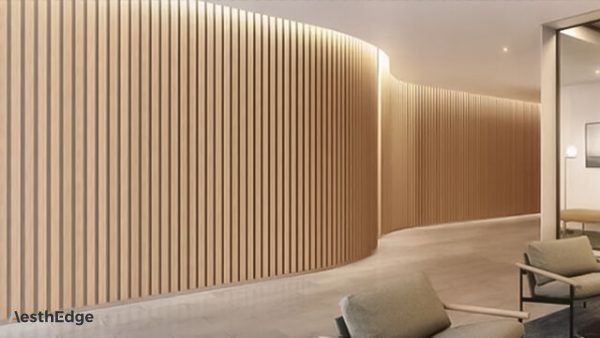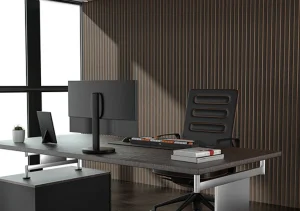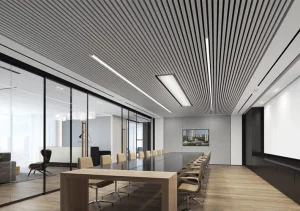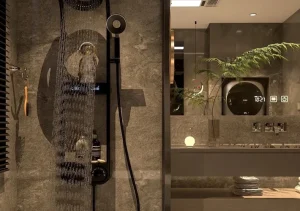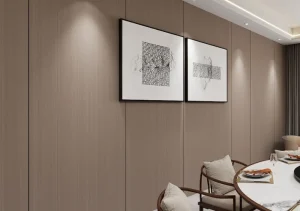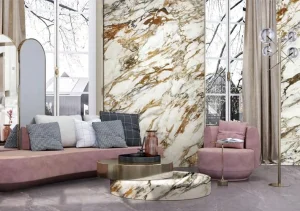In the realm of hotel decoration, every design element serves a dual purpose: aesthetics and functionality. Among the innovative materials reshaping hospitality spaces, acoustic slat wall panels have emerged as a game-changer. These versatile installations blend visual appeal with sound-dampening capabilities, addressing two critical needs of modern hotels—creating visually striking interiors and ensuring a peaceful, comfortable environment for guests. As a leading Chinese supplier of decorative materials and hotel FF&E, we understand the unique demands of the hospitality industry, and acoustic slat wall panels stand out as a solution that aligns with both practicality and luxury. In this article, we explore the multifaceted advantages of acoustic slat wall panels in hotel decoration, from their acoustic performance to their design flexibility, durability, and beyond.
Table of Contents
ToggleSuperior Acoustic Performance: Enhancing Guest Comfort
One of the most pressing challenges in hotel design is managing noise. Hotels are bustling environments: hallways echo with the sound of rolling luggage, elevators hum, neighboring rooms share thin walls, and common areas like lobbies or restaurants buzz with conversation. For guests seeking relaxation or privacy, unwanted noise can significantly detract from their experience, leading to negative reviews and reduced repeat bookings. Acoustic slat wall panels are engineered to tackle this issue head-on, making them an invaluable asset in hotel decoration.
How Acoustic Slat Wall Panels Work
Acoustic slat wall panels consist of a series of wooden or composite slats mounted on a backing board, with strategically placed gaps between the slats. Behind these slats lies a layer of sound-absorbing material—often mineral wool, foam, or recycled fibers—that traps and dissipates sound waves. This combination of slats and absorbent core disrupts the path of noise, reducing both airborne sound (such as voices or music) and impact noise (like footsteps or slamming doors).
In hotel rooms, where privacy is paramount, these panels can be installed on walls adjacent to hallways or neighboring rooms, effectively reducing sound transmission by up to 30-50% compared to traditional drywall. In lobbies, which often suffer from excessive reverberation due to high ceilings and hard surfaces, acoustic slat panels absorb echo, making conversations clearer and the space feel more inviting. Even in restaurants or bars within hotels, where ambient noise can rise to uncomfortable levels, these panels help maintain a pleasant atmosphere, allowing guests to enjoy their meals without straining to hear each other.
Meeting Guest Expectations
Modern travelers prioritize comfort, and a quiet room ranks high on their list of requirements. A survey by the American Hotel & Lodging Association found that 78% of guests consider “a quiet stay” as a top factor in choosing a hotel. Acoustic slat wall panels directly address this expectation, creating spaces where guests can relax, work, or sleep undisturbed. By investing in acoustic solutions, hotels not only improve guest satisfaction but also differentiate themselves in a competitive market, where positive reviews often hinge on the quality of rest and privacy.
Aesthetic Versatility: Elevating Design Possibilities
Beyond their functional benefits, acoustic slat wall panels are a designer’s dream, offering endless possibilities to enhance a hotel’s visual identity. Unlike traditional acoustic materials, which often prioritize function over form, these panels seamlessly blend performance with style, making them suitable for any design theme—from minimalist and contemporary to rustic and luxurious.
Material and Finish Options
Acoustic slat panels are available in a wide range of materials, each with its own unique texture and appearance. Wooden slats—crafted from oak, walnut, pine, or bamboo—add warmth and natural elegance, ideal for boutique hotels or lodges aiming for a cozy, organic feel. For a more modern aesthetic, metal slats (in finishes like brushed steel or matte black) introduce industrial chic, perfect for urban hotels or trendy design-focused properties. For eco-conscious brands, recycled composite slats (made from sustainable materials like bamboo fibers or recycled plastic) offer a green alternative without compromising on style.
Finishes also play a key role in customization. Slats can be stained, painted, or left in their natural state to match a hotel’s color palette. For example, a beachfront resort might opt for light, bleached wood slats to complement its airy, coastal theme, while a luxury downtown hotel could choose dark walnut slats to exude sophistication. Additionally, panels can be designed with varying slat widths or spacing patterns—from narrow, uniform gaps to wider, asymmetrical arrangements—adding visual interest and depth to walls.
Integration with Existing Design Elements
Acoustic slat wall panels are highly adaptable, allowing them to harmonize with other design elements in a hotel. In lobbies, they can serve as a focal point behind reception desks, paired with statement lighting or greenery to create a welcoming first impression. In guest rooms, they can be used as an accent wall behind the bed, complementing headboards, artwork, or textiles. In restaurants, they can divide dining areas subtly, adding privacy while maintaining an open, spacious feel.
Moreover, these panels can be curved or shaped to fit architectural features, such as rounded walls or alcoves, making them a versatile choice for hotels with unique layouts. Whether used sparingly as an accent or more extensively to cover entire walls, acoustic slat panels add a layer of sophistication that elevates the overall design, turning functional spaces into visually memorable ones.
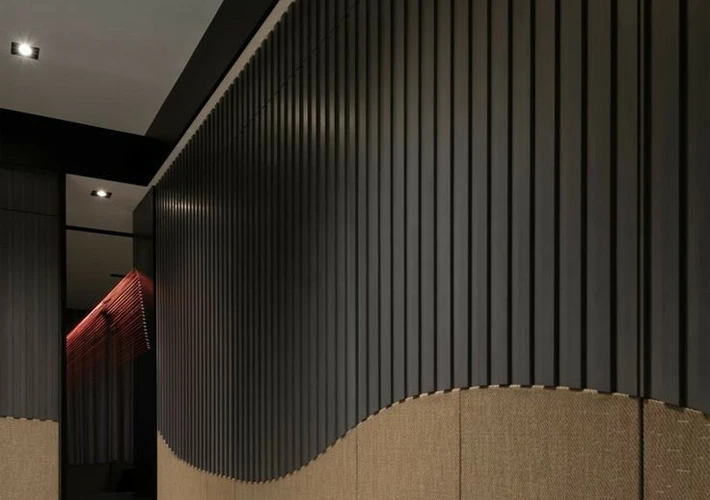
Durability and Low Maintenance: A Practical Investment for Hotels
Hotels operate 24/7, with high foot traffic, frequent cleaning, and constant use of spaces. Any decorative material used in such environments must withstand wear and tear while requiring minimal upkeep. Acoustic slat wall panels excel in this regard, offering durability and ease of maintenance that make them a practical long-term investment.
Built to Last
The construction of acoustic slat wall panels ensures longevity. The slats themselves are typically made from high-density materials—such as solid wood, engineered wood, or metal—that resist warping, cracking, or fading, even with prolonged exposure to sunlight, humidity, or temperature fluctuations. This is particularly important in hotels, where rooms may be subject to varying conditions (e.g., air conditioning in summer, heating in winter) or high humidity in areas like spas or indoor pools.
The backing boards and sound-absorbing cores are also designed for durability. Many panels use moisture-resistant backing materials, preventing mold or mildew growth in damp environments. Additionally, the slats are securely fastened to the backing, reducing the risk of loosening or damage from accidental impacts (such as luggage brushing against walls in hallways).
Easy Cleaning and Upkeep
Unlike fabric-based acoustic solutions, which can trap dust, stains, or odors, acoustic slat wall panels are easy to clean. Wooden or composite slats can be wiped down with a damp cloth or mild cleaning solution, while metal slats may require only a quick dusting to maintain their shine. This low-maintenance nature is a boon for hotel housekeeping teams, who can keep spaces looking pristine without investing in specialized cleaning tools or time-consuming routines.
Furthermore, if a slat becomes damaged (e.g., a scratch on a wooden panel), it can often be replaced individually rather than replacing the entire panel. This reduces repair costs and minimizes downtime, ensuring that hotel spaces remain functional and attractive even with occasional wear.
Sustainability: Aligning with Eco-Friendly Hotel Trends
In recent years, sustainability has become a core focus for the hospitality industry. Travelers are increasingly choosing hotels that prioritize environmental responsibility, and brands are responding by adopting eco-friendly practices—from energy-efficient lighting to waste reduction. Acoustic slat wall panels align with this trend, offering sustainable options that appeal to both hotels and their environmentally conscious guests.
Use of Renewable and Recycled Materials
Many acoustic slat panels are crafted from renewable resources, such as FSC-certified wood (sourced from responsibly managed forests) or bamboo, which grows quickly and requires minimal water. For hotels aiming to reduce their carbon footprint, these materials provide a guilt-free alternative to non-renewable options.
Additionally, a growing number of manufacturers (including our own) offer panels made from recycled materials, such as reclaimed wood or recycled plastic composites. These panels give new life to waste materials, reducing the demand for virgin resources and lowering the environmental impact of production. By choosing such panels, hotels can highlight their commitment to sustainability in marketing materials, appealing to eco-conscious travelers and enhancing their brand reputation.
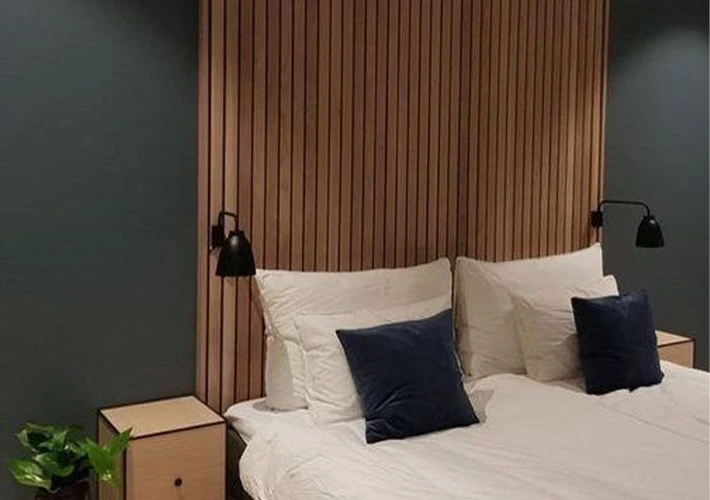
Energy Efficiency and Indoor Air Quality
Acoustic slat wall panels also contribute to energy efficiency in hotels. The sound-absorbing cores within the panels often have insulating properties, helping to regulate room temperatures by reducing heat transfer through walls. This can lower the workload on heating and cooling systems, reducing energy consumption and utility costs.
Furthermore, unlike some traditional acoustic materials that may contain harmful chemicals (such as volatile organic compounds, or VOCs), many modern slat panels are low-VOC or VOC-free. This ensures that they do not release toxic fumes into the air, improving indoor air quality and creating healthier spaces for guests and staff. For hotels prioritizing wellness—a growing trend in hospitality—this is a significant advantage, as clean air contributes to a more comfortable and rejuvenating stay.
Cost-Effectiveness: Balancing Quality and Budget
While luxury and functionality are key in hotel design, budget considerations are always a factor. Acoustic slat wall panels offer a cost-effective solution, providing long-term value that justifies their initial investment.
Reduced Need for Additional Acoustic Treatments
Traditional hotel construction often requires multiple layers of materials to address noise issues—such as soundproof drywall, insulation, and separate acoustic panels. This not only increases material costs but also adds to labor expenses, as each layer requires installation time. Acoustic slat wall panels combine sound absorption and structural support in a single product, eliminating the need for multiple treatments. This streamlines the installation process and reduces overall costs, making them a more economical choice.
Longevity and Reduced Replacement Costs
As mentioned earlier, acoustic slat panels are highly durable, with a lifespan of 10-15 years or more when properly maintained. This longevity means hotels do not need to replace them frequently, unlike less durable materials that may wear out in 3-5 years. Over time, this reduces long-term expenses, making the initial investment in slat panels a wise financial decision.
Competitive Pricing from Chinese Suppliers
As a Chinese supplier, we leverage efficient manufacturing processes and access to high-quality raw materials to offer acoustic slat wall panels at competitive prices without compromising on quality. This affordability allows hotels of all scales—from budget-friendly chains to luxury resorts—to incorporate these panels into their designs, ensuring that even smaller properties can benefit from their advantages.
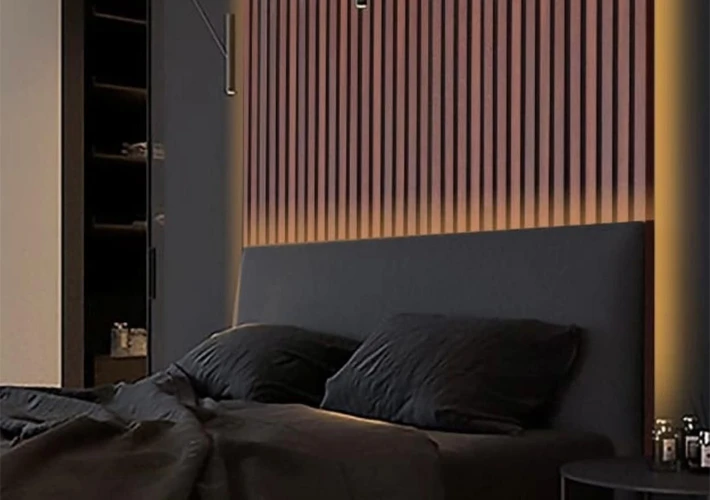
Easy Installation and Customization: Adapting to Hotel Schedules
Hotel renovations or new constructions often operate on tight schedules, with minimal downtime to avoid disrupting guest stays. Acoustic slat wall panels are designed with ease of installation in mind, making them a practical choice for projects with strict timelines.
Simplified Installation Process
Unlike complex acoustic systems that require specialized tools or training, acoustic slat wall panels are typically installed using straightforward methods. Many panels come with a tongue-and-groove system or mounting brackets, allowing contractors to secure them to walls quickly. This reduces installation time, minimizing disruptions to hotel operations. For example, a guest room renovation that might take 2-3 days with traditional materials can often be completed in a day with slat panels, allowing rooms to be returned to service faster.
Custom Sizing for Any Space
Hotels feature a variety of room sizes and layouts, from compact standard rooms to spacious suites and irregularly shaped lobbies. Acoustic slat panels can be custom-cut to fit any dimension, ensuring a perfect fit without gaps or awkward edges. This customization extends to curved walls, corners, or even ceiling installations, making them suitable for unique architectural features. As a supplier, we work closely with hotels and contractors to provide panels tailored to their specific measurements, ensuring a seamless installation process.
Enhancing Brand Identity: Creating Memorable Spaces
A hotel’s design is a reflection of its brand identity. Whether a property aims to convey luxury, sustainability, innovation, or warmth, every design element contributes to this narrative. Acoustic slat wall panels offer a versatile canvas to reinforce brand values and create spaces that resonate with guests long after their stay.
Reinforcing Luxury and Sophistication
For luxury hotels, the choice of materials speaks volumes about quality and exclusivity. Acoustic slat panels made from premium woods (like black walnut or teak) or metal (like brass or copper) exude opulence, elevating the sense of luxury in guest rooms, spas, or fine dining areas. Their clean lines and 精致 finishes align with high-end design aesthetics, creating an atmosphere of refinement that appeals to discerning travelers.
Highlighting Innovation and Modernity
Boutique or design-focused hotels often aim to stand out with cutting-edge aesthetics. Acoustic slat panels with unconventional shapes, bold colors, or mixed materials (like wood and glass) convey innovation, positioning the hotel as a trendsetter. These panels can become a signature design element, featured in marketing campaigns or social media posts, attracting guests seeking unique experiences.
Emphasizing Local Culture and Heritage
Many hotels draw inspiration from their location, incorporating local culture or heritage into their design. Acoustic slat panels can be customized to reflect regional traditions—for example, using wood species native to the area or patterns inspired by local art. This not only creates a sense of place but also fosters a connection between guests and the destination, enhancing their overall travel experience.
Conclusion: Why Acoustic Slat Wall Panels Are a Must-Have for Modern Hotels
In the competitive world of hospitality, every detail matters. Acoustic slat wall panels offer a rare combination of functionality, aesthetics, sustainability, and cost-effectiveness, making them an indispensable tool in hotel decoration. By addressing noise pollution, enhancing design flexibility, ensuring durability, and aligning with eco-friendly trends, these panels contribute to guest satisfaction, brand differentiation, and long-term operational success.
As a leading Chinese supplier of decorative materials and hotel FF&E, we are committed to providing high-quality acoustic slat wall panels tailored to the unique needs of hotels worldwide. Whether you’re designing a luxury resort, a boutique hotel, or a budget-friendly chain, our panels offer a solution that balances performance and style, helping you create spaces that guests will love—and return to.

